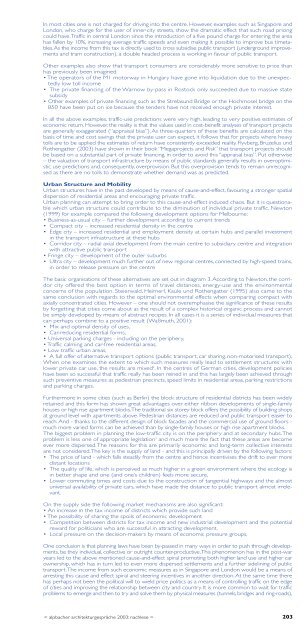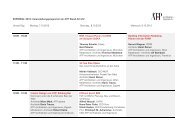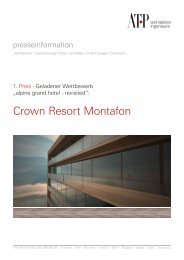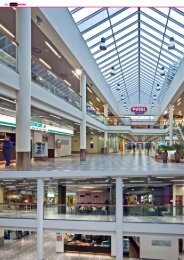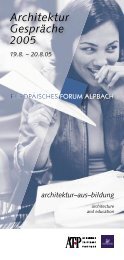alpbacher architekturgespräche 2003 - ATP
alpbacher architekturgespräche 2003 - ATP
alpbacher architekturgespräche 2003 - ATP
Erfolgreiche ePaper selbst erstellen
Machen Sie aus Ihren PDF Publikationen ein blätterbares Flipbook mit unserer einzigartigen Google optimierten e-Paper Software.
In most cities one is not charged for driving into the centre. However, examples such as Singapore and<br />
London, who charge for the user of inner-city streets, show the dramatic effect that such road pricing<br />
could have.Traffic in central London since the introduction of a five pound charge for entering the area<br />
has fallen by 10%, increasing average traffic speeds and even making it possible to improve bus timetables.As<br />
the income from this tax is directly used to cross subsidise public transport (underground improvements<br />
and tram construction), a double headed process is working in favour of public transport.<br />
Other examples also show that transport consumers are considerably more sensitive to price than<br />
has previously been imagined.<br />
• The operators of the M1 motorway in Hungary have gone into liquidation due to the unexpectedly<br />
low toll income<br />
• The private financing of the Warnow by-pass in Rostock only succeeded due to massive state<br />
subsidy<br />
• Other examples of private financing such as the Strelasund Bridge or the Hochmosel bridge on the<br />
B50 have been put on ice because the tenders have not received enough private interest.<br />
In all the above examples, traffic-use predictions were very high, leading to very positive estimates of<br />
economic return. However, the reality is that the values used in cost-benefit analyses of transport projects<br />
are generally exaggerated (“appraisal bias”). As three-quarters of these benefits are calculated on the<br />
basis of time and cost savings that the private user can expect, it follows that for projects where heavy<br />
tolls are to be applied the estimates of return have consistently exceeded reality. Flyvberg, Bruzelius und<br />
Rothengatter (<strong>2003</strong>) have shown in their book “Megaprojects and Risk” that transport projects should<br />
be based on a substantial part of private financing, in order to avoid this “appraisal bias”. Put otherwise<br />
– the valuation of transport infrastructure by means of public standards generally results in overoptimistic<br />
use predictions and, consequently, overprovision. But this overprovision tends to remain unrecognised<br />
as there are no tolls to demonstrate whether demand was as predicted.<br />
Urban Structure and Mobility<br />
Urban structures have in the past developed by means of cause-and-effect, favouring a stronger spatial<br />
dispersion of residential areas and encouraging private traffic.<br />
Urban planning can attempt to bring order to this cause-and-effect induced chaos. But it is questionable<br />
which urban structure could contribute to the diminution of individual private traffic. Newton<br />
(1999) for example compared the following development options for Melbourne:<br />
• Business-as-usual city – further development according to current trends<br />
• Compact city – increased residential density in the centre<br />
• Edge city – increased residential and employment density at certain hubs and parallel investment<br />
in the transport infrastructure at these hubs<br />
• Corridor city – radial axial development from the main centre to subsidiary centre and integration<br />
with attractive public transport<br />
• Fringe city – development of the outer suburbs<br />
• Ultra city – development much further out of new regional centres, connected by high-speed trains,<br />
in order to release pressure on the centre<br />
The basic organisations of these alternatives are set out in diagram 3.According to Newton, the corridor<br />
city offered the best option in terms of travel distances, energy-use and the environmental<br />
concerns of the population. Steierwald, Heimerl, Kaule und Rothengatter (1995) also came to the<br />
same conclusion with regards to the optimal environmental effects when comparing compact with<br />
axially concentrated cities. However – one should not overemphasise the significance of these results<br />
by forgetting that cities come about as the result of a complex historical organic process and cannot<br />
be simply developed by means of abstract recipes. In all cases it is a series of individual measures that<br />
can perhaps combine to a positive result (Waßmuth, 2001):<br />
• Mix and optimal density of uses,<br />
• Car-reducing residential forms,<br />
• Universal parking charges - including on the periphery,<br />
• Traffic calming and car-free residential areas,<br />
• Low traffic urban areas,<br />
• A full offer of alternative transport options (public transport, car sharing, non-motorised transport),<br />
When one examines the extent to which such measures really lead to settlement structures with<br />
lower private car use, the results are mixed 2 . In the centres of German cities, development policies<br />
have been so successful that traffic really has been reined in and this has largely been achieved through<br />
such preventive measures as pedestrian precincts, speed limits in residential areas, parking restrictions<br />
and parking charges.<br />
Furthermore in some cities (such as Berlin) the block structure of residential districts has been widely<br />
retained and this form has shown great advantages over either ribbon developments of single-family<br />
houses or high rise apartment blocks.The traditional six storey block offers the possibility of building shops<br />
at ground level with apartments above. Pedestrian distances are reduced and public transport easier to<br />
reach. And - thanks to the different design of block facades and the commercial use of ground floors -<br />
much more varied forms can be achieved than by single-family houses or high rise apartment blocks.<br />
The biggest problem in planning the low-traffic city is on the periphery and at secondary hubs.The<br />
problem is less one of appropriate legislation 3 and much more the fact that these areas are become<br />
ever more dispersed.The reasons for this are primarily economic and long-term collective interests<br />
are not considered.The key is the supply of land - and this is principally driven by the following factors:<br />
• The price of land - which falls steadily from the centre and hence incentivises the drift to ever more<br />
distant locations<br />
• The quality of life, which is perceived as much higher in a green environment where the ecology is<br />
in better shape and one (and one’s children) feels more secure,<br />
• Lower commuting times and costs due to the construction of tangential highways and the almost<br />
universal availability of private cars, which have made the distance to public transport almost irrelevant.<br />
On the supply side the following market mechanisms are also significant:<br />
• An increase in the tax income of districts which provide such land<br />
• The possibility of sharing the spoils of economic development<br />
• Competition between districts for tax income and new industrial development and the potential<br />
reward for politicians who are successful in attracting development,<br />
• Local pressure on the decision-makers by means of economic pressure groups,<br />
One conclusion is that planning laws have been by-passed in many ways in order to push through developments,<br />
be they individual, collective or outright counter-productive.This phenomenon has in the post-war<br />
years led to the above mentioned cause-and-effect spiral promoting both higher land use and higher car<br />
ownership, which has in turn led to even more dispersed settlements and a further sidelining of public<br />
transport.The income from such economic measures as in Singapore and London would be a means of<br />
arresting this cause and effect spiral and steering incentives in another direction.At the same time there<br />
has perhaps not been the political will to wield price politics as a means of controlling traffic on the edge<br />
of cities and improving the relationship between city and country. It is more common to wait for traffic<br />
problems to emerge and then to try and solve them by physical measures (tunnels, bridges and ring-roads),<br />
< <strong>alpbacher</strong> <strong>architekturgespräche</strong> <strong>2003</strong>: nachlese > 203


